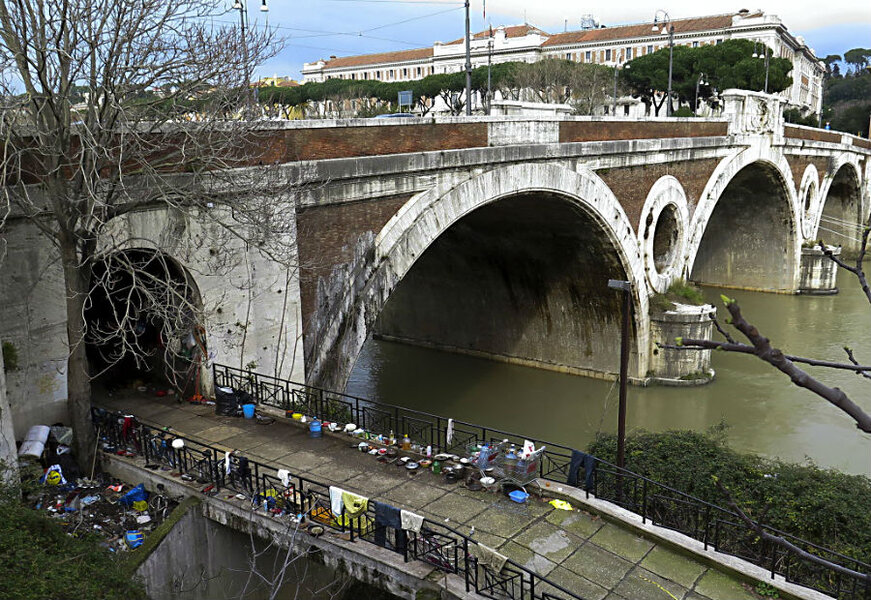From the Tiber to the Ganges, volunteers gather to clean waterways
Loading...
Frustrated with the city of Rome's failure to maintain the Tiber River, a group of volunteers has taken its restoration into their own hands. Not only in Rome, but globally, cleanup crusades have swept up (literally) other important rivers of the world, including the Rhine, the Ganges, and the Charles in Boston.
The Tiber, on which the city of Rome was founded, according to legend, was once deified as the god Tiberinus. Yet today, the banks of the river are covered in graffiti, litter, homeless encampments, and overgrown vegetation, while its waters endure murk and filth. Although Roman city officials have been promising for decades to clean up the river's banks, they have yet to do so, citing a lack of money and resources.
Now several groups of volunteers have decided to take Rome's inaction as an opportunity to pursue various environmental and artistic initiatives. One such initiative, known as reverse graffiti, uses stencils and power-washing to reduce the organic and inorganic grime on the river embankment. The 500-yard-long project, called "Triumphs and Laments," depicts a procession of characters, such as Cicero or St. Theresa, throughout Roman history.
"There's no specific narrative, except that everyone's triumphs and glories is someone else's laments and shamefulness," says William Kentridge, a South African artist who conceived of the project. "It was a real challenge getting contemporary art accepted in the heart of ancient Rome."
The Tiber cleanup follows in the tradition of decades-long river cleanup throughout the world. During central Europe's economic resurgence in the 1960s and '70s, the Rhine's increased pollution wiped out several species of fish and other animals native to the iconic European river. By the end of the '70s, efforts among various countries to clean up the Rhine coalesced as a story of international cooperation.
In 1987, members of the ICPR (International Commission for the Protection of the Rhine) adopted the Rhine Action Plan to guarantee drinking water, reduce the amount of mercury, lead, cadmium, and dioxins by 50-75 percent, build basins to collect fire extinction water, tighten safety norms in industrial plants, rehabilitate the Rhine's ecology and fish passages, and restore the plants and animals typical of the Rhine habitat. Today the Rhine supplies drinking water for over 20 million people.
In India, the river Ganges runs from the Himalayas, passing through 29 cities, picking up garbage, waste, and even dead bodies from each of them. The Ganges is the fifth most polluted river in the world, yet provides water to more than a third of the Indian population.
India's prime minister Narendra Modi vowed to clean up the river, having announced Namami Ganga, an Integrated Ganges Development Project, in 2014. Modi allocated $334 million to clean the river within three years, though India's supreme court was critical, saying his plan couldn't clean the Ganges even within 200 years.
Still, the plight of the holy river Ganges, worshipped by Hindus, has brought together an international effort, including Germany, Israel, the United Kingdom, and Japan, to help India with its cleanup. The Rhine cleanup plan has been an inspiration for the Ganges.
In the United States as well, river cleanup brought together more than 3,000 volunteers in Boston this past Earth Day to pick up litter, remove invasive species, and assist in park maintenance around the Charles River. The Annual Earth Day Charles River Cleanup is part of a larger effort called the American Rivers' National River Cleanup, which has cleaned up more than 20 million pounds of trash from American rivers.
In Rome, many of the Tiber's would-be saviors see the efforts they have made so far as a starting point. The banks of the Tiber will eventually be the site of international cultural projects, says Kristin Jones, a New York-based artist who founded Tevereterno, the group sponsoring "Triumphs and Laments." The Tiber is “the spine of the city," Ms. Jones told The New York Times, "and it could become a magnificent park.”





